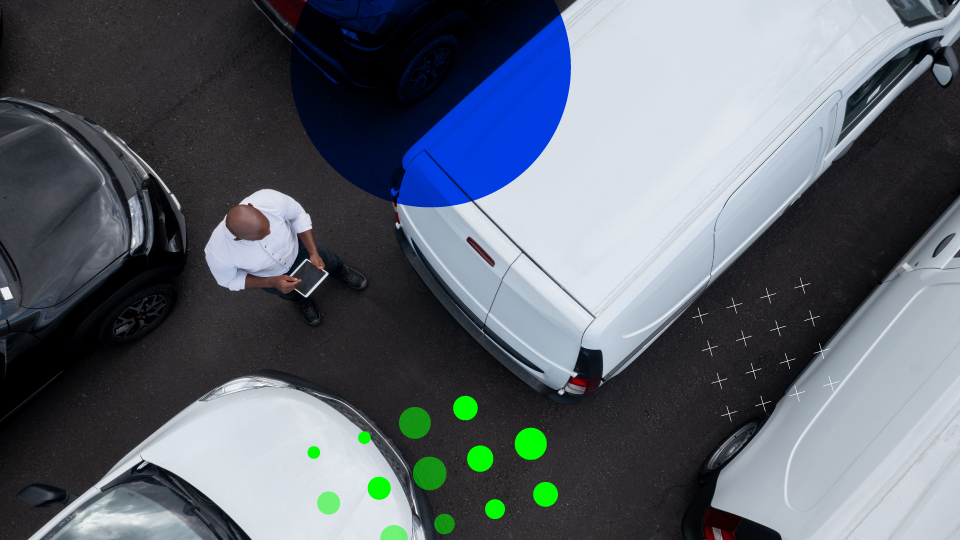
Boosting public safety operations through integrated technology solutions
Last updated on May 3, 2024 in Public Sector by Andrew Forest | 4 minute read
Table of contents
“Frontline Innovations: Harnessing Leading-Edge Technology in Public Safety with Esri, Axon and Geotab” at Geotab Connect 2024 showcased how software transforms the efficiency of public safety operations.
Nathalie Crewes, Public Safety Business Segment Manager at Geotab, hosted Jon Pedder, GIS Senior Solutions Engineer at Esri and Blake Bullock, VP of Devices and Product Management at Axon to discuss innovations that enhance how first responders protect their communities.
Revolutionizing law enforcement technology with Axon
The discussion opened with a brief explanation about how early mobile technologies developed, paving the way for the solutions that law enforcement uses today to manage and collect evidence. Given the current wealth of data available and the administrative work involved with studying it, it’s important for agencies to have tools at their disposal that reduce investigative confusion and enhance precision. Axon’s connected technologies enable departments to enhance efficiency and collect better information, helping them find the truth faster. Integrated solutions like law enforcement software, TASER less-lethal devices and field cameras foster better public service, extend the value of existing police funding and work to preserve life.
With this technology, officers are able to spend more time in the field serving the public and less time completing manual tasks with the support of automation. Axon’s seamless compatibility with different third-party systems also helps agencies efficiently manage, organize and share large troves of evidence and eliminate disorganization.
GPS data of on-duty officers’ vehicles also proves to be essential to helping police departments build effective workflows, enhance situational awareness and issue critical support during dangerous situations. Using data from Geotab and Axon’s technology, supervisors and dispatchers can stay updated on where officers and squad vehicles are at all times. If a sidearm is used or a vehicle collision occurs, automatic alerts can prompt Axon cameras to begin live streaming video from the field for supervisors to watch. Through a system of connected capabilities that enhance collaboration between department supervisors and field responders, Axon’s solutions empower law enforcement to gain more situational awareness and real-time information, and ultimately protect more lives, which is the centerpiece of their corporate mission.
Bullock provided a use case in Virginia of how Axon’s solutions for law enforcement helped give clarity in the aftermath of a high-pressure public safety situation. During this incident involving two individuals and a suspected stolen vehicle, a police officer was attempting to make an arrest. As he was trying to apprehend one of the suspects, the other aimed a gun at him at point blank range, forcing the officer to draw his weapon and fire. Axon’s sensor-based cameras automatically began capturing the unfolding events once the officer’s own firearm was drawn, saving critical footage in real time. When contradictory information about the situation was presented afterward, these videos demonstrated an objective picture of the truth, ultimately corroborating the police officer and department’s accounts.
Powerful GIS software use cases for public safety with Esri
In the Esri presentation, Pedder explained how Esri’s GIS solution empowers public safety departments like law enforcement, fire and emergency response to analyze smarter insights and operate more efficiently with 3D mapping technology. GIS, or geographic information software, is a digital solution used to study and manage geospatial information with multiple geographical data layers such as base maps, live feeds and operational layers. Esri’s GIS system integrates with other software to consolidate all relevant field data within a single, easy-to-digest solution.
For decision-makers in public safety departments, this high level of geospatial data sharing can help them identify operational challenges in real time and more efficiently direct their workforces. Pedder shared several different applications of Esri’s GIS in action for public safety.
Law enforcement: Agencies can import data into Esri’s platform to view the regions that see higher concentrations of crime. This helps them better anticipate which areas may need increased officer presence or backup dispatching, then help them evaluate the results of any new policing strategies. Esri can also be used during homicide or burglary investigations to plot data-related items like cell phone locations, weather patterns and cellular towers.
Fire: Completed fire hydrant inspections and the locations of firefighters once they’ve left their fire engines can be mapped with Esri, helping fire departments gain stronger visibility over their operations.
Emergency response: Using GIS to study topographical trends and forecast how climate change could affect an area’s geography can help departments prepare stronger disaster recovery plans in advance. Understanding where and what kinds of buildings should be constructed in relation to areas that are potentially susceptible to flooding, earthquakes or landslides is critical to prevent damage and know the best ways to respond in the event of a catastrophe.
Regardless of the use case, GIS software can help public safety organizations spatially analyze many contrasting data types with a single platform. Visualizing how geography might affect this data empowers teams to make smarter decisions and develop advanced public service strategies.
Future opportunities, goals and AI’s potential to enhance public safety
Crewes provided deeper insight into the objectives of Geotab, Esri and Axon. She explained how there could be future opportunities to explore the connective potential of each respective platform and that each organization is committed to promoting public sector safety. By offering cutting-edge software, hardware and data for the front line and being in collective alignment for greater public good, our companies are helping agencies and departments keep individuals safer.
Another audience question centered around how public safety agencies might use new artificial intelligence (AI) tools to improve their administrative workflows. Our speakers discussed how generative AI could help officers save time during the report writing process if it is able to clear certain accuracy checks. AI also may be able to help public safety employees complete interactive data queries. By prompting an AI tool to survey given data sets and create a slide deck or video based on what’s been captured, administrative employees could work more efficiently.
Frontline innovations: Solutions that drive effective incident response
Using the public safety technologies of Geotab, Axon and Esri, organizations can collect different data sets and study holistic trends in their workforces. Integrated software and equipment can help public safety agencies automatically capture indispensable details while their employees do their jobs, resulting in quicker response times and fewer distractions to keeping citizens safe. Solutions developed in close collaboration with public safety teams will help their employees reach those in need faster, transforming the ways agencies serve their jurisdictions.
Interested in learning more about Geotab’s diverse applications for public safety? Schedule a free demo to see how our fleet management solutions can improve security, efficiency and accountability in your team.
If you liked this post, let us know!
Disclaimer
Geotab's blog posts are intended to provide information and encourage discussion on topics of interest to the telematics community at large. Geotab is not providing technical, professional or legal advice through these blog posts. While every effort has been made to ensure the information in this blog post is timely and accurate, errors and omissions may occur, and the information presented here may become out-of-date with the passage of time.
Get industry tips and insights
Sign up for monthly news and tips from our award-winning fleet management blog. You can unsubscribe at any time.
Other posts you might like

A fleet’s guide to multi-stop route planners
April 24, 2024

Public sector fleet electrification: Sharing insights from learned experiences at Connect 2024
April 18, 2024

The Impact of the California Clean Truck Check on Your Fleet
March 27, 2024

Geotab 2024 discussion recap: A Data-Driven Journey in Fleet Maintenance
March 11, 2024






